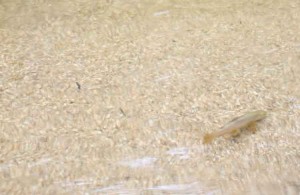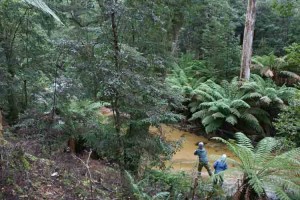Trout Fishing like its 1959…
Earlier in the month I wrote a blog (online diary) entry titled ‘fishing like its 1959’. Back when Australian fly fishing author David Scholes’ was fishing the Tasmanian streams, early-season flood fishing was the first event of the year, followed by the classic mayfly hatches of spring Show Day. Well, for the first time in my 8 year guiding career, we’ve started the season with classic Scholes-esque flood water feeders, gorging on drowned worms and grubs, and it looks like the best mayfly season in decades is about to hatch.
About 6 years ago, myself and my friend Aarron fished our first major hatch on the upper Macquarie River. This river, and its mayfly hatches, were made famous by the writings of David Scholes earlier in the 50’s and 60’s. The day of our first hatch was magical–morning ceanid mayflies greeted us, large red spinner duns hatched at lunch, and giant red spinners fell on evening. We landed 22 fish, 8 over two pounds, and lost the biggest few fish of the day, perhaps up to 5lbs in weight. All of this took place on a section of river less than a cast wide, with lovely grassy undercuts sheltering the wild browns as they sipped mayfly from the current seams, and weedy runnels. These hatches continued through until late November, when water levels dropped, and we moved on to the larger rivers and their later pre-Christmas hatches.
The following year I again fished the upper Macquarie, found some good hatches over two weeks or so, but didn’t achieve any once-in-a-lifetime red-letter days. A further season on and I managed to fish one solitary hatch during the making of In Season Tasmania, but by that November water levels were too low, the paddocks were parched, and the only thing cruising were starving tiger snakes and the odd redfin perch. The frogs were quiet, the mayflies in remission, and the water had turned an algal brown. Five years of drought had taken its toll, and the fishery was on life-support.
But now there is great news. For the first time in many, many years, I’ll be fishing the spring mayfly hatches on rivers such as the upper Macquarie. The drought has been broken by the third biggest wet in a century, with the east coast of Tasmania receiving more than 700mm of rain over winter. The rivers have been flushed, the headwater soaks and springs replenished, and the mayfly are ready to go. As harsh as the past seasons have been on some of the midland’s rivers, these insects will go into reproductive overdrive, shortening their breeding-cycles to booster populations. The trout that have spent the past few seasons on a maintenance diets have added fat to their lengthy frames, with worms, cockchafer beetles and grubs providing the early season fodder. It’s a time to re-visit the fisheries of old, and fish like its 1959. See you on the river.
If you’d like to book some time fly fishing the spring mayfly hatches with RiverFly Tasmania, send us an enquiry now. We have spaces available in October for the start of the hatches, and very limited spaces in November and December.
-
Fishing report for August and early September
For a rundown of the fishing to mid-August, read our blog (online diary) here.
The rains continued into September, with flood-feeders still the primary target until late last week. RiverFly guide Patrick Horan’s earthworm fly was the outstanding fly pattern of the period, with lake and river fish finding it irresistible. The headwater creeks offered the most consistent fishing, much of it polaroiding, though well timed trips to the South Esk, Macquarie, and St Patricks rivers resulted in great flood fishing for lucky anglers.
An interesting by-product of the big-wet has been prolific midge hatches on the lakes. Nearly every lake in Tasmania is now full (with the exception of Lake Gordon, Great Lake and Lake Echo). This has meant that kilometres of previously dry shorelines are again underwater. As the flooded vegetation (grasses etc) rot, they provide food for invertebrate populations, and the midges have been the first to explode in numbers. This has led to dry fly fishing opportunities on Lake Huntsman in particular. Other lakes that have fished well in the past couple of weeks have been Lake Echo (with access now available to the marshes at the top end), Great Lake and the Bronte Chain.
My last trip to the Western Lakes was opening day, with all the lakes from Augusta right out to the back lakes full and overflowing. Since then, persistent highland rain and snow has kept the road access closed while Lake Augusta spills. I’m anticipating a visit to the Western Lakes later in the month, so stay tuned to our blog for a report.
-
New Project from the ‘In Season Tasmania’ Team
For fans of the book In Season Tasmania – A Year of Fly Fishing Highlights, you’ll be interested to read that I have just embarked on my next ‘artistic’ endeavour. I’m keeping cagey on the details for now, but all will come to light on the RiverFly blog over the next month, as a winter of planning turns into a season of action. Super-photographer, FlyLife Magazine staffer, and In Season co-author Brad Harris will be one of a cast who’ll be joining me on parts of the next project, providing inspiring images along the way.
-
Product Reviews
· Whiting Eurohackle
Relatively new to Australia are Whiting Eurohackles, available from the Essential Fly Fisher in Launceston. These are dry-fly saddles in the traditional sense, but this breed of rooster caters for a range of larger than normal sizes. For a long time now, size 8-10 dry fly hackles, or over-sized hackles for parachute flies have been hard to come by. The Eurohackle fills this void, with saddles catering for 8’s, 10’s or 12’s, depending on the individual saddle selected. I’ve been using them on size 10 and 12 parachute duns, and give them two thumbs up!
· New Sage 99 fly rod
Sage have just released a new model rod called the 99. These are 9’ 9’’ inch rods, specifically designed for European style nymphing. My first impressions from casting this rod are that it will be awesome for its specific job. The length is ideal, the sensitive and slow tapered tip will be well suited for casting and ‘feeling’ the nymphs as they fish, and the low-down power will offer plenty of oomph for pulling rainbows out of white-water pockets. If you’re trying to picture what the rod feels like in action and balance, think of a rod built with a graphite bottom half, and fibreglass tip. This rod will be a hit among the competition fishing scene, and those wanting to fish this effective style of fishing.
-
Quamby Estate – RiverFly lodge accommodation
Quamby Estate, RiverFly’s lodge accommodation partner, has been receiving some great reviews of late. To read more about the charms of the estate, follow these links to recent reviews: , the Sydney Morning Herald, or pick up a copy of the latest FlyLife Magazine, Spring 2009.
Guests booking our 3 Rivers Package with lodge accommodation receive free airport transfers from Launceston to Quamby Estate.
That’s all for now. Thank you for your loyal business which has led to record pre-season bookings for season 09/10. We look forward to showing you some of our new river venues this season, or perhaps leading you on a Western Lakes wilderness campout. For more information visit our website at www.riverfly.com.au
Thank you from the RiverFly team: Daniel, Simone and Patrick.




